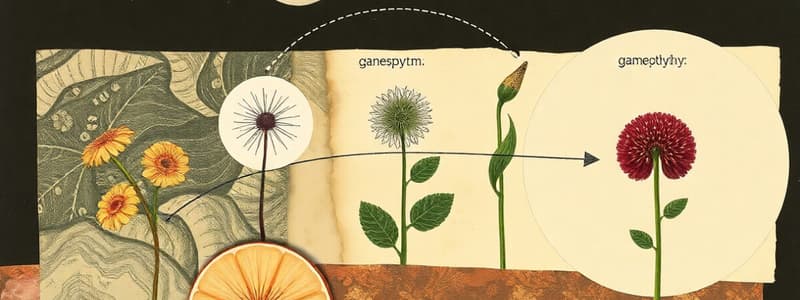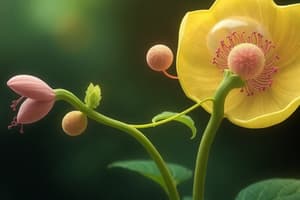Podcast
Questions and Answers
What is the process of double fertilization in angiosperms?
What is the process of double fertilization in angiosperms?
Double fertilization is a process unique to angiosperms where two sperm nuclei, produced by the male gametophyte, are involved in fertilization. One sperm nucleus fertilizes the egg cell to form a diploid zygote, while the other sperm nucleus fuses with the two polar nuclei, which are located in the central cell of the female gametophyte, to form a triploid endosperm nucleus. This endosperm nucleus will eventually develop into endosperm tissue, which provides nourishment to the developing embryo.
What are the two main components of the male gametophyte, and what do they do in the process of fertilization?
What are the two main components of the male gametophyte, and what do they do in the process of fertilization?
The two main components of the male gametophyte are the generative cell and the tube cell. The tube cell forms the pollen tube, which grows towards the ovule and delivers the sperm nuclei from generative cell to the ovule. The generative cell divides mitotically to produce two sperm nuclei, which eventually fuse with the egg and central cell, leading to fertilization and development of the embryo and endosperm.
What is the function of the embryo sac in the angiosperm female gametophyte?
What is the function of the embryo sac in the angiosperm female gametophyte?
The embryo sac is a structure in the female gametophyte that, during fertilization, contains seven cells: one egg cell, two synergid cells, three antipodal cells, and the central cell that has two polar nuclei. When the pollen tube reaches the ovule, the sperm nuclei are delivered to the embryo sac, where fertilization occurs, leading to the development of the embryo and endosperm.
How does the endosperm develop in angiosperms?
How does the endosperm develop in angiosperms?
What is the significance of the process of pollination for angiosperms?
What is the significance of the process of pollination for angiosperms?
Describe the development of the female gametophyte within the angiosperm ovule, highlighting the key stages.
Describe the development of the female gametophyte within the angiosperm ovule, highlighting the key stages.
Explain the role of the pollen tube in the fertilization process of angiosperms.
Explain the role of the pollen tube in the fertilization process of angiosperms.
Explain how the development of the embryo sac differs from the development of the male gametophyte in angiosperms.
Explain how the development of the embryo sac differs from the development of the male gametophyte in angiosperms.
The development of the angiosperm life cycle is a continuous process without any resting stages.
The development of the angiosperm life cycle is a continuous process without any resting stages.
What are the four main stages of angiosperm development?
What are the four main stages of angiosperm development?
Flashcards
Double Fertilization
Double Fertilization
The fusion of gametes in angiosperms, involving one sperm fertilizing the egg to form a zygote, and another sperm fusing with the polar nuclei to form a triploid nucleus.
Pollination
Pollination
The process by which a pollen grain reaches the receptive stigma, potentially leading to fertilization.
Integuments
Integuments
The protective sporophytic tissue surrounding each megasporangium in the ovule.
Micropyle
Micropyle
Signup and view all the flashcards
Megasporocyte
Megasporocyte
Signup and view all the flashcards
Embryo Sac
Embryo Sac
Signup and view all the flashcards
Megaspore
Megaspore
Signup and view all the flashcards
Synergid Cells
Synergid Cells
Signup and view all the flashcards
Antipodal Cells
Antipodal Cells
Signup and view all the flashcards
Polar Nuclei
Polar Nuclei
Signup and view all the flashcards
Megasporangium
Megasporangium
Signup and view all the flashcards
Microsporocyte
Microsporocyte
Signup and view all the flashcards
Microsporangium
Microsporangium
Signup and view all the flashcards
Pollen Grain
Pollen Grain
Signup and view all the flashcards
Generative Cell
Generative Cell
Signup and view all the flashcards
Tube Cell
Tube Cell
Signup and view all the flashcards
Pollen Tube Germination
Pollen Tube Germination
Signup and view all the flashcards
Endosperm
Endosperm
Signup and view all the flashcards
Seed
Seed
Signup and view all the flashcards
Fruit
Fruit
Signup and view all the flashcards
Cotyledons
Cotyledons
Signup and view all the flashcards
Germination
Germination
Signup and view all the flashcards
Angiosperm Gametophytes
Angiosperm Gametophytes
Signup and view all the flashcards
Microspore Formation
Microspore Formation
Signup and view all the flashcards
Male Gametophyte Development
Male Gametophyte Development
Signup and view all the flashcards
Pollen Tube Growth
Pollen Tube Growth
Signup and view all the flashcards
Sperm Formation
Sperm Formation
Signup and view all the flashcards
Endosperm Development
Endosperm Development
Signup and view all the flashcards
Seed Development
Seed Development
Signup and view all the flashcards
Sporophyte Development
Sporophyte Development
Signup and view all the flashcards
Study Notes
Angiosperm Life Cycle Overview
- Angiosperm life cycle focuses on gametophyte development, pollen tube delivery, double fertilization, and seed development.
- Gametophytes are reduced in size and dependent on sporophytes for nutrients.
- Angiosperm gametophytes consist of a few microscopic cells.
Development of Female Gametophytes (Embryo Sacs)
- Ovules form within the ovary.
- A female gametophyte (embryo sac) develops inside each ovule within the megasporangium.
- Protective tissues (integuments) surround the megasporangium except for a gap called the micropyle.
- Megasporocyte undergoes meiosis to produce four haploid megaspores, usually only one survives.
- Mitosis occurs three times in the surviving megaspore forming a multinucleate mass, this differentiates into the embryo sac.
- The embryo sac contains eight haploid nuclei arranged in seven cells: egg, two synergids, a central cell with two polar nuclei, and three antipodal cells.
- The micropyle area contains synergids that attract and guide pollen tubes.
Development of Male Gametophytes in Pollen Grains
- Anthers produce microsporangia (pollen sacs).
- Microsporocytes undergo meiosis to form four haploid microspores.
- Each microspore develops into a male gametophyte (pollen grain) through mitosis.
- The pollen grain contains two cells: a generative cell and a tube cell.
- Pollen grains are released from the anthers.
Sperm Delivery by Pollen Tubes
- Pollen grain lands on a receptive stigma, germinates, and forms a pollen tube.
- The generative cell divides into two sperm cells (male gametes).
- The pollen tube grows through the style toward the micropyle.
- The tube cell leads the way; and the two sperm cells are released near the embryo sac.
Double Fertilization
- Two sperm cells are released near the embryo sac.
- One sperm fertilizes the egg cell forming a diploid zygote (future sporophyte).
- The other sperm fuses with the two polar nuclei in the central cell forming a triploid endosperm (food storage for the seedling).
- This process is known as double fertilization.
Seed Development
- After fertilization, the ovule develops into a seed.
- The ovary develops into a fruit, which protects and disperses seeds.
- Seeds store food for the seedling (endosperm).
- The embryo develops from the zygote, aided by nutrient storage.
Key Differences Compared to Other Plants
- The unique process of double fertilization, in which two sperm fuse with different female gametophyte cells.
- Reduced gametophytes (vs other plants, where they are more prominently displayed).
Studying That Suits You
Use AI to generate personalized quizzes and flashcards to suit your learning preferences.




